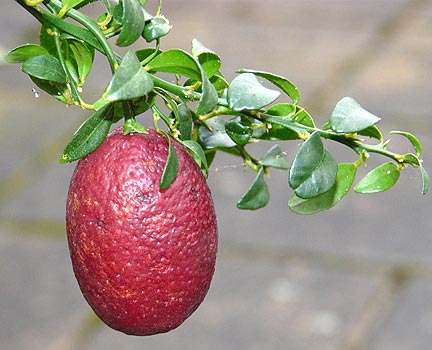The Blood Limes are relatively acidic like a lemon, but are excellent when used in sauces. They can also be used as an ingredient for preserves, condiments and beverages, or fresh as an attractive garnish for sweet and savoury dishes. They are less aromatically perfumed than a true lime.


This is a hybrid citrus resulting from the open pollination of a flower of Citrus australasica var. sanguinea - the red finger lime, until recently known botanically as Microcitrus australasica. The pollen parent was either a Rangpur lime or an Ellendale Mandarin. Both these varieties are themselves citrus hybrids. The Rangpur is probably a cross between a lemon and a mandarin, and so sometimes called a lemanderin. It is an attractive fruit with a very acidic taste and orange peel and flesh. The Ellendale originated in Bundaberg, Queensland, Australia around 1878. It is believed to be a natural cross of a mandarin and an orange. The Ellendale Mandarin fruit is deep orange, with high sugar as well as acid content, which gives it a rich, sweet, tangy flavour.
The original Blood Lime parent tree was selected in 1990 at CSIRO, Merbein, Victoria, Australia. This agricultural research facility closed in 2009, and all the citrus plants were destroyed. The land was sold in 2012.
Under the right conditions the tree produces striking, blood-red coloured fruit, on an attractive, dense, upright shrub to small tree, usually 2m to 3 m high and 2m wide. It has dark, glossy-green foliage and purple-red growth flushes. The oval shaped leaves are approximately 25 to 35mm long by 15mm wide, with slightly serrated edges. Short, stiff, slender spines (which can damage the fruit) are present in the leaf axils.
Fruits ripen in winter, are oval in shape and are usually 30 to 50 mm long, by 20 to 30 mm wide. The skin colour may range from gold, with red flecking, to a uniform intense blood red, while flesh and juice may show red tinges or may occasionally be more intensely red. Seasonal, geographic and harvest timing appear to influence the intensity of colour development. At Merbein, the fruit of their experimental planting ripened in June to August with the fruit remaining on the tree with colour until October. For the northern hemisphere, this equates to ripening in December to February, and hanging until April.
Seeds are small and plump. Juice squeezed from the fruit has a sharp, crisp, clean flavour.
or Red Centre Lime
Note that most of the above information, and photos, has been gathered from various web-sites which I acknowledge with thanks. They include:-
The following set of photos was taken in her Sydney garden by Kath - a prolific provider of excellent plant photos on the Flickr web-site . These are reproduced here with her permission.
The higher definition originals can be found on Flickr under CSSK - citrus fruits album.
In 2006 I was sent budwood labelled 'Blood Lime'. Just two of my buddings survived and grew. The far left was taken in October 2007 when the best plant had reached almost 1m tall. Summer 2008 brought the first flowers, followed by the very dark, purple-black fruits photographed in October. Finally, they turned to the predicted red in January 2009.
However, flash photography does readily enhance their appearance. In reality the fruits are a dark, purplish-red - much more like congealed blood rather than fresh!
Fancy some Blood Lime marmalade?
for a recipe!
See also my webpage about
page created 2nd October 2008
modified 15th June 2018












